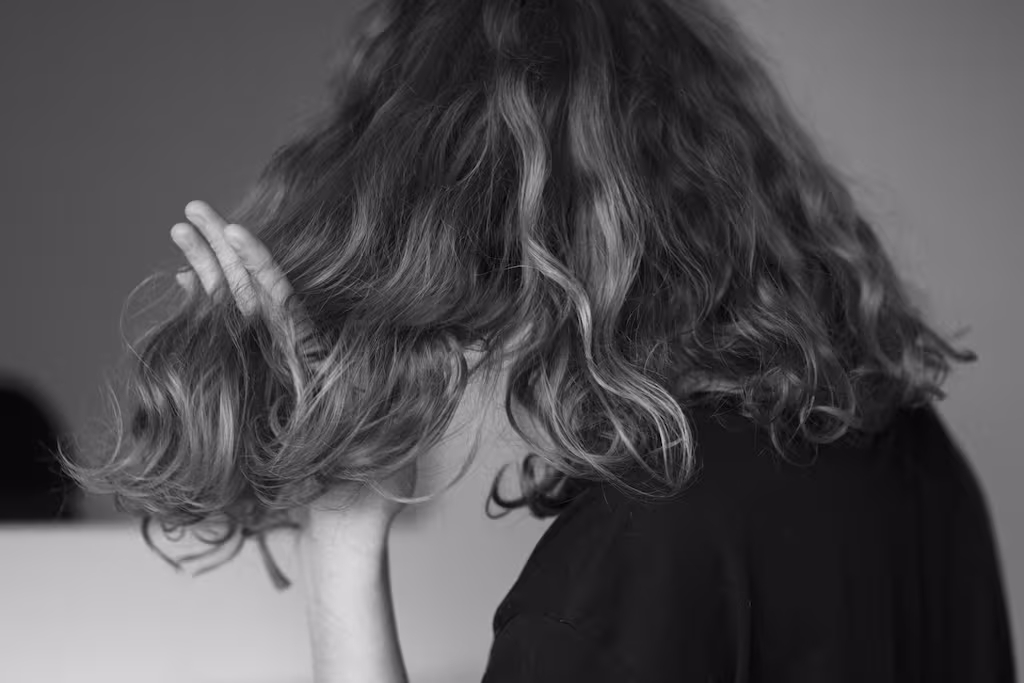
Oil is spreading across the popular social media app, as users enthuse about the archaic practice of oiling your hair and scalp. But is this much-hyped technique actually beneficial?
Did you know that the skin on your scalp ages six times faster than your face? While it might not be fine lines and wrinkles making themselves known beneath your head of hair, there are plenty of ways that your scalp shows signs of ageing and distress — think dandruff, psoriasis, itchiness and perhaps the most feared of all, hair loss — and it requires dedicated care. One of the most talked about hair loss treatments on TikTok right now is the Ayurvedic practice of hair oiling.
At the time of writing, there are 289 million posts about hair oiling on TikTok. Many of them tout the hair growth benefits of this ancient practice and conversely (in true TikTok fashion) there are plenty of users sharing that taking to the scalp with an oil has left their hair in worse condition than when they began. So what’s the deal?
Hair oiling has ancient roots and is particularly prevalent in cultures of South Asia, especially India. The practice dates back thousands of years and is deeply embedded in Ayurvedic traditions, which emphasise the use of natural oils for therapeutic purposes. Hair oiling has also been practised in other parts of the world, including Africa, the Middle East, and Southeast Asia, where various oils are used for their beneficial properties.
Like many ancient wellbeing practices (tongue scraping, yoga, gua sha and oil pulling, to name a few) Westerners on social media have begun to popularise the technique, but as with everything in the world of beauty and wellness, one size does not fit all — especially when it comes to treating hair loss.
As a certified trichologist, Act+Acre founder Helen Reavey emphasises the importance of scalp treatments for different scalp and hair goals but when it comes to hair loss, there are certain conditions that can be helped with topical practices such as hair oiling, and those that require medical intervention to see an improvement in hair growth.
What hair-loss conditions can hair oiling improve?
“Scalp oiling and treatments can be very beneficial for certain types of hair loss, particularly those related to scalp health and hair shaft strength,” says Reavey. “Keeping the skin hydrated and the hair follicle clean allows for healthy blood flow and nutrients to the hair follicle, which is so important for healthy hair growth.”
Temporary hair loss resulting from stress, hormonal changes or nutritional deficiencies, known as telogen effluvium, is one type of condition that can benefit from hair oiling, as this can help improve scalp health and provide the necessary nutrients to support hair regrowth.
Likewise, where conditions such as dandruff, seborrheic dermatitis and general scalp dryness have led to hair thinning, oils can soothe the scalp, reduce inflammation and maintain a healthy scalp environment, all of which are essential for hair growth.
“If hair is prone to breakage and damage, oiling can strengthen the hair shaft, adding shine and reducing breakage,” she explains.
Hair loss conditions which require medical treatment include androgenetic alopecia (pattern baldness), alopecia areata, scarring alopecias, severe nutritional deficiencies or hormonal imbalances.
Which scalp types benefit most from the addition of oils?
“Typically if you have an oily face, you’ll likely have a more oily-prone scalp, and the same goes for dry to normal skin types,” says Reavey, so as with your skincare, you need to consider whether the product is the right fit for the skin on your scalp in order to see an improvement in its condition.
For those with a dry scalp, Reavey says oiling provides much-needed hydration and moisture, can reduce flakiness, soothe irritation and prevent itchiness. If you have a “normal” scalp (that is, no skin or hair loss concerns), maintaining the health of your scalp is important for keeping the balance of moisture and oil. Oiling can enhance hair strength and add shine while encouraging healthy hair growth.
“For an oily scalp I recommend a chemical scalp exfoliator, something with a BHA formulated with salicylic acid, to cut through the surface oil and exfoliate deep within the hair follicles to remove build-up and restore balance to your scalp’s ecosystem,” suggests Reavey.
And for anyone experiencing dandruff, Reavey recommends avoiding any product with lipids (oils and waxes). “The fungus, malassezia, is a common culprit behind dandruff and it feeds on the oils secreted by the scalp. Instead use a chemical exfoliant scalp treatment to remove that oil and clear loose flakes,” she says.
What is the best hair oiling technique?
Oils can be applied to both the scalp and to the lengths and ends of the hair, resulting in different benefits.
“Massaging the scalp increases blood circulation, which helps deliver more nutrients and oxygen to the hair follicles, thus promoting healthier hair growth,” says Mukti, founder of Mukti Organics and author of Truth In Beauty, a guide to holistic beauty alternatives.
“By providing essential nutrients and improving blood circulation to the scalp, hair oiling can support and possibly accelerate hair growth over time.”
In her book, Mukti suggests coating your hair with oils such as coconut, olive, marula, jojoba or sesame oil before shampooing it to help maintain the pH balance of the hair and scalp and prevent surfactants in shampoo from stripping the hair of oils.
“The oil forms a protective layer around the hair, shielding it from environmental damage and harsh weather conditions helping to prevent breakage and split ends,” she says.
How to hair oil
Choose the right oil: Commonly used oils include coconut oil, olive oil, almond oil, argan oil, and castor oil. If you’d rather choose a pre-blended oil, see our recommendations below.
Warm the oil (optional): Slightly warm the oil to enhance its penetration into the scalp and hair. Ensure it’s not too hot to avoid burns.
Section your hair: Divide your hair into sections to ensure even application.
Apply to scalp: Using your fingertips, gently massage the oil into your scalp. This stimulates blood circulation and helps the oil penetrate the roots.
Apply to hair: Spread the oil through the length of your hair, focusing on the ends, which are more prone to dryness and damage.
Massage: Spend a few minutes massaging your scalp and hair to ensure the oil is evenly distributed and absorbed.
Leave it on: Leave the oil on for at least an hour. For better results, you can leave it overnight. Use a shower cap to prevent the oil from staining your pillow.
Wash off: Rinse out the oil with a mild shampoo. You may need to shampoo twice to completely remove the oil. Follow with a conditioner if needed.
Frequency: Depending on your hair type and needs, oil your hair once or twice a week.
Choosing the right oil for your hair and scalp type
Many natural oils are rich in vitamins, minerals, and fatty acids but not all oils are created equal and it’s important to choose the right one for your hair and scalp needs, says Mukti.
“For instance, coconut oil contains lauric acid, which can penetrate the hair shaft and reduce protein loss. Other oils like argan oil and jojoba oil provide antioxidants and vitamins that can strengthen hair.”
These are her top suggestions:
Coconut oil: Great for deep conditioning and reducing protein loss.
Argan oil: Rich in antioxidants, perfect for dry, coloured or damaged hair.
Jojoba oil: Mimics the scalp’s natural sebum, making it ideal for balancing oil production and treating a dry scalp.
Baobab oil: Great for curly hair as it contains conditioning properties that assist hair elasticity.
Grapeseed oil: Good for frizzy hair or damaged, split ends.










 闽公网安备35021102002035号
闽公网安备35021102002035号